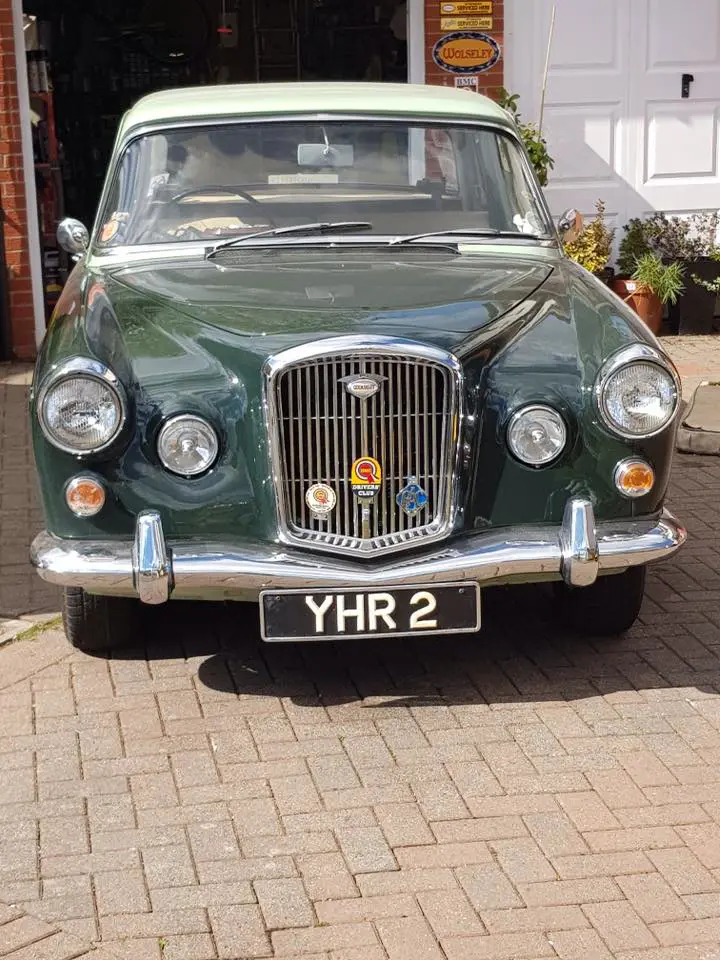MEET THE OWNER – STEPHEN GREEN AND HIS WOLSELEY 6/99
28 September 2022
When the British Motor Corporation introduced the 6/99 in July 1959, they claimed it was “Undoubtedly the finest of Wolseley of all”. Stephen would no doubt agree with the brochure and his stunning example is one of only two known survivors in duotone green. As he explains, “the original owner, Mrs. E. Johnson, was from Bradford on Avon and she took delivery on the 2nd May 1961, but she decided that she did not like its Tawny paint finish and red upholstery. And so, within a very short time, the Wolseley was given its current striking Connaught and Porcelain Green exterior with a cabin trimmed in beige hide.

The 6/99 represented BMC’s third line-up of cars with styling by Pininfarina; the first two being the Austin A40 and Wolseley 15/60 of 1958. In terms of marketing, it bridged the gap between the Austin A99 Westminster and the Princess 3-Litre (which was Vanden Plas-badged from 1960), all of which featured the six-cylinder C-series engine in 2,912cc form and power-assisted front brakes. Stephen believes that the ‘Big Farina’ carry off their Italian American lines with more flair than their 1.5-litre stablemates and it must be said that YHR 2 looks downright jaunty. A bank manager who wished to cut a dash at weekends at the golf course would have found a Wolseley in duotone green the perfect car.
The Green 6/99 is fitted with the optional Borg Warner transmission, rather than the standard three-speed manual change with dual overdrive. Stephen remarks “I do find the automatic gearbox better suited to the Wolseley. There is also an under-dashboard switch for the ‘Intermediate Gear Hold’, but I have never been tempted to use it! Power steering became an option in 1961 but my car was retrofitted with PAS quite a while after the 6/99 was commissioned and it does make a significant difference to parking and town driving”.
Some younger readers may be wondering at this point why the Corporation felt the need to offer what was fundamentally the same car under three different badges. The reasons for the separate Austin, Wolseley, and Vanden Plas relate to BMC’s having to satisfy its various dealership outlets, an issue they never managed to resolve, and - quite frankly – the British class system. To quote again the famous 1966 ‘Class Sketch”, the Wolseley was the Ronnie Barker of the “Big Farina” family. At £1,255 it was far less expensive than a Humber Super Snipe or a Rover P5 and Motor Sport perfectly summarised its appeal - “This luxury car at a low price goes well with bowler hats and rolled umbrellas”.
As for YHR, it is the last of the 6/99s; BMC unveiled the facelifted 6/110 in 1961. Happily, Mrs. Johnson is still with us, while Stephen takes justifiable pride in being the custodian of such a distinguished motor car – “so many of them ended their life on the banger circuit”. And it is always surprising how much a change of colour may alter a car’s personality. If a black Wolseley denotes B-film law enforcement, the shades of Connaught and Porcelain Green evoke summer motoring accompanied by the BBC Light Programme. And lashings of ginger beer.
With Thanks To: Stephen Green.
